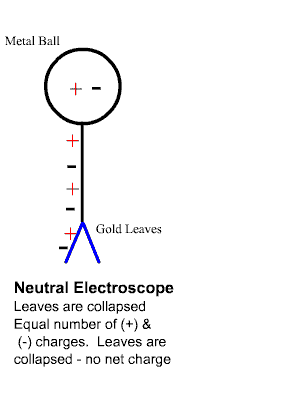Charging: Induction & Conduction or Contact
Conduction:
free electrons are physically transmitted from a charged object to a neutral object or vice versa.
When an object is charged by conduction (or contact) both the "charging" object and the object being charged will acquire the same charge.
Induction:
free electrons are either attracted towards or repelled away from the charging object. T
he shift in electrons within the object polarizes the object being charged whereby one end will be positive and the opposite end will be negative (or vice versa).
When an object is charged by induction the "charging" object and the object being charged will momentarily acquire the opposite charge.
The electroscope
The electroscope is a simple instrument that can give us a qualitative measurement of the amount of charge on an object.
Here is a diagram of a neutral electroscope: note that the leaves are collapsed because the number of positive particles and negative particles balance each other out.

The animation below shows how an electroscope works:
Essentially when a charge is placed on the ball of the electroscope it's gold leaves at the bottom of the stem will either collapse or spread apart.
An electroscope can also be used to predict the type of charge on an object.
Note that the positive charges (protons) remain always stationary.
Only the electrons can travel trough conductors and are responsible for the movement of charges.



